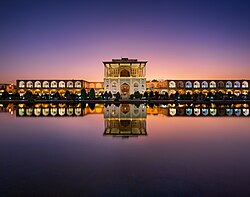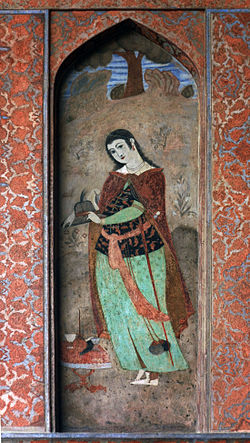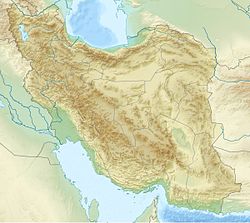
Back عالي قابو Arabic Ali Qapı Azerbaijani آلاقاپی (ایصفاهان) AZB Али Капу Bulgarian Álí Qápú Czech Palacio de Ali Qapu Spanish عالیقاپو Persian Ali Qapou French עאלי קאפו HE Ալի Ղափու պալատ Armenian
| Ali Qapu | |
|---|---|
عالیقاپو, ‘Ālī Qāpū | |
 Ali Qapu photographed during the golden hour | |
 Location in Naqsh-e Jahan Square | |
| General information | |
| Type |
|
| Architectural style | |
| Location | Isfahan, Iran |
| Opened | 1597 |
| Client | Safavid Emperors |
| Owner | Islamic Republic of Iran |
| Official name | Naqsh-e Jahan square and Ali Qapu Palace |
| Location | Isfahan, Isfahan Province, Iran |
| Criteria | Cultural: (i)(v)(vi) |
| Reference | 115 |
| Inscription | 1979 (3rd Session) |
| Coordinates | 32°39′26″N 51°40′36″E / 32.65722°N 51.67667°E |

Ali Qapu (Persian: عالیقاپو, ‘Ālī Qāpū)(lit: "Grand Gate") is an imperial palace in Isfahan, Iran. It is located on the western side of the Naqsh-e Jahan Square, opposite to the Sheikh Lotfollah Mosque, and had been originally designed as a vast portal entrance to the grand palace which stretched from Naqsh-e Jahan Square to Chaharbagh Boulevard. UNESCO inscribed the Palace and the Square as a World Heritage Site due to their cultural and historical importance. The palace is forty-eight meters high and there are six floors, each accessible by a difficult spiral staircase. In the sixth floor, Music Hall, deep circular niches are found in the walls, having not only aesthetic value, but also acoustic. Ali Qapu is regarded as the best example of Safavid architecture and a symbol of Iran's Islamic heritage.

The name Ali Qapu, from Persian ‘Ālī (meaning "imperial" or "great"), and Azerbaijani Qāpū (meaning "gate"), was given to this place as it was right at the entrance to the Safavid palaces which stretched from the Naqsh-e Jahan Square to the Chahar Baq Boulevard. The building, another wonderful Safavid edifice, was built by decree of Shah Abbas the Great in the early seventeenth century. It was here that the great monarch used to entertain noble visitors, and foreign ambassadors. Shah Abbas, here for the first time, celebrated the Nowruz (Iranian New Year) of 1006 AH/1597 C.E.
Wall decorations were highly favored in palace decorations and Ali Qapu was no exception. Ali Qapu is rich in naturalistic wall paintings by Reza Abbasi, the court painter of Shah Abbas I, and his pupils. There are floral, animal, and bird motifs in his works. The highly ornamented doors and windows of the palace have almost all been pillaged at times of social anarchy. Only one window on the third floor has escaped the ravages of time. Ali Qapu was repaired and restored substantially during the reign of Shah Soltan Hoseyn, the last Safavid ruler, but fell into a dreadful state of dilapidation again during the short reign of invading Afghans. Under the reign of Naser ad-Din Shah Qajar (1848–96), the Safavid cornices and floral tiles above the portal were replaced by tiles bearing inscriptions.
Shah Abbas II was enthusiastic about the embellishment and perfection of Ali Qapu. His chief contribution was given to the magnificent hall, the constructors on the third floor. The 18 columns of the hall are covered with mirrors and its ceiling is decorated with great paintings.
The chancellery was stationed on the first floor. On the sixth, the royal reception and banquets were held. The largest rooms are found on this floor. The stucco decoration of the banquet hall abounds in motif of various vessels and cups. The sixth floor was popularly called the Music Hall. Here various ensembles performed music and sang songs.
From the upper galleries, the Safavid shahs watched Chowgan (polo), army maneuvers and horse-racing in the Naqsh-e Jahan square.[1][unreliable source?]
The palace is depicted on the reverse of the Iranian 20,000 rials banknote.[2] The palace is also depicted on the reverse of the Iranian 20 rials 1953 banknote series.[1]
- ^ a b "Iran 20 Rials banknote 1953 Mohammad Reza Shah Pahlavi". www.worldbanknotescoins.com. Retrieved 2017-04-21.
- ^ Central Bank of Iran Archived 2021-02-03 at the Wayback Machine. Banknotes & Coins: 20000 Rials Archived 2009-04-09 at the Wayback Machine. – Retrieved on 24 March 2009.
© MMXXIII Rich X Search. We shall prevail. All rights reserved. Rich X Search
